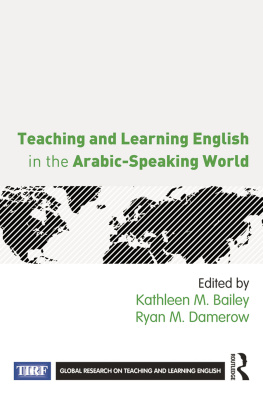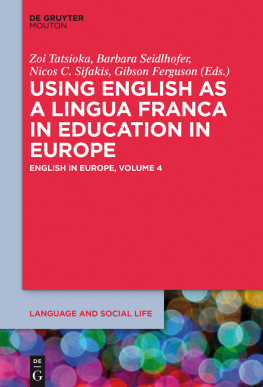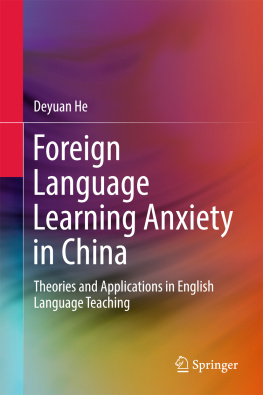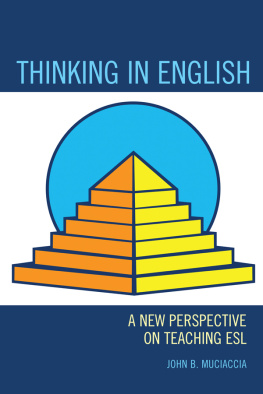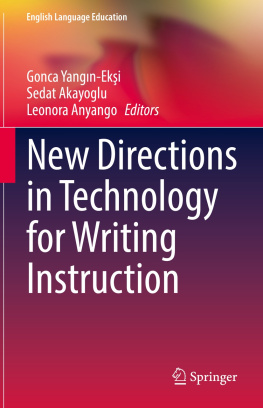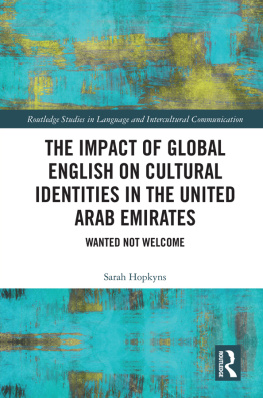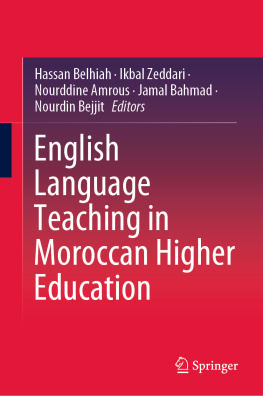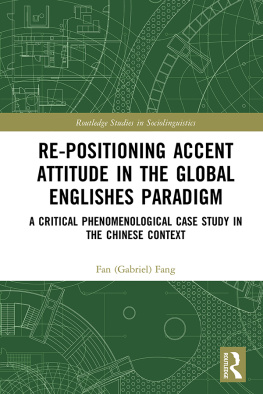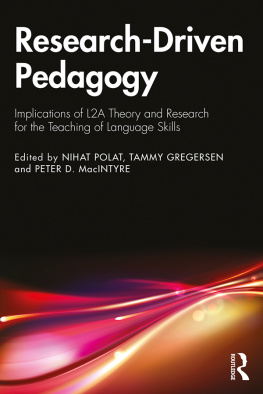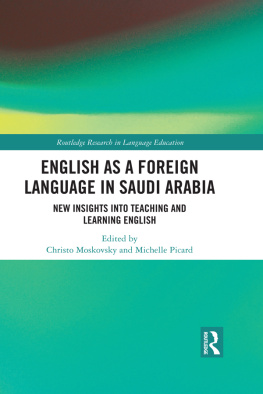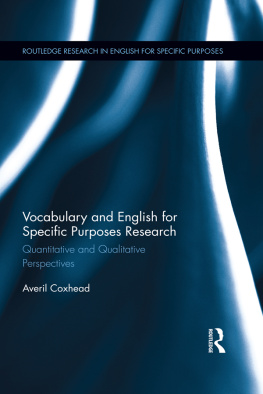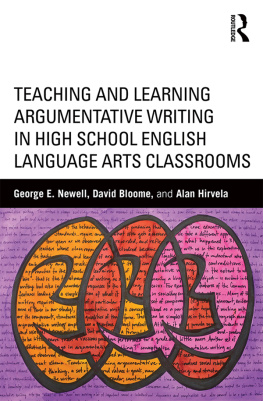TEACHING AND LEARNING ENGLISH IN THE ARABIC-SPEAKING WORLD
A fascinating insight into the diversity of issues that language educators in the Middle East grapple with.
Dudley Reynolds, Carnegie Mellon University in Qatar
an essential resource for those individuals who are interested in the latest research from the Arab world.
Christine Coombe, Dubai Mens College, UAE
An important contribution to the emerging body of research-based knowledge about teaching English to native speakers of Arabic, this volume presents empirical studies carried out in Egypt, Lebanon, Oman, Palestine, Saudi Arabia, and the United Arab Emirates (UAE)a region which has gained notable attention in the past few decades. Each chapter addresses an issue of current concern, and each includes implications for policy, practice, and future research. Nine chapter authors are Sheikh Nahayan Fellowsrecipients of doctoral fellowships from The International Research Foundation for English Language Education (TIRF). This volume is the first in the Global Research on Teaching and Learning English Series, co-published by Routledge and TIRF.
Kathleen M. Bailey is a Professor of Applied Linguistics in the Master of Arts in the TESOL-TFL Program at the Monterey Institute of International Studies, and President of The International Research Foundation for English Language Education (TIRF).
Ryan M. Damerow is the Executive Assistant of The International Research Foundation for English Language Education (TIRF).
GLOBAL RESEARCH ON TEACHING AND LEARNING ENGLISH
Co-published with The International Research Foundation for English Language Education (TIRF)
Kathleen M. Bailey & Ryan M. Damerow, Series Editors
Bailey & Damerow, Eds.
Teaching and Learning English in the Arabic-Speaking World
For additional information on titles in the Global Research on Teaching and Learning English series, visit www.routledge.com/books/series/TIRF
First published 2014
by Routledge
711 Third Avenue, New York, NY 10017
and by Routledge
2 Park Square, Milton Park, Abingdon, Oxon OX14 4RN
Routledge is an imprint of the Taylor & Francis Group, an informa business
2014 Taylor & Francis
The right of the editor to be identified as the author of the editorial material, and of the authors for their individual chapters, has been asserted in accordance with sections 77 and 78 of the Copyright, Designs and Patents Act 1988.
All rights reserved. No part of this book may be reprinted or reproduced or utilised in any form or by any electronic, mechanical, or other means, now known or hereafter invented, including photocopying and recording, or in any information storage or retrieval system, without permission in writing from the publishers.
Trademark notice: Product or corporate names may be trademarks or registered trademarks, and are used only for identification and explanation without intent to infringe.
Library of Congress Cataloging-in-Publication Data
Teaching and learning English in the Arabic-speaking world / edited by Kathleen M. Bailey and Ryan M. Damerow
pages cm. (Global research on teaching and learning english)
Includes bibliographical references and index.
1.English languageStudy and teachingArabic speakers.2.English languageStudy and teachingArab countries.3.English languageStudy and teachingMiddle East.I.Bailey, Kathleen M.II.Damerow, Ryan M.
PE1130.A8T432014
428.0071'056dc232013032601
ISBN: 978-0-415-73563-6 (hbk)
ISBN: 978-0-415-73564-3 (pbk)
ISBN: 978-1-315-81885-6 (ebk)
Typeset in Bembo
by Apex CoVantage, LLC
DEDICATION
We dedicate this book to Sheikh Nahayan bin Mubarak Al Nahayan, the Minister of Culture, Youth, and Community Development of the United Arab Emirates. The Sheikh has stated that a countrys future is dependent on the level of education provided to its people. We hope this book adds to the investment that he has made in his country, while helping to establish a cohort of researchers in the Arabic-speaking world.
We remain grateful to Sheikh Nahayan for his vision of furthering English language education in the Arab World, through providing TIRF the financial support to establish a network of researchers who focus on particular issues affecting Arabic-speaking learners of English. The authors of these chapters join us in acknowledging both the Sheikhs foresight and his generosity.
CONTENTS
Yehia El-Ezabi
Kathleen M. Bailey
Ryan M. Damerow
Ryan M. Damerow
Kathleen M. Bailey
Abdul Gabbar Al-Sharafi
Muhammad M.M. Abdel Latif
Hassan El-Nabih
Melanie van den Hoven
Fodhna Gardiner-Hyland
Fatima Esseili
Enas Hammad
Mansoor Al-Surmi
Laila W. Rumsey
Kholoud A. Al-Thubaiti
G. Richard Tucker
Yehia El-Ezabi
The history of education, as that of all spheres of human development, is a record of the vision and insights of pioneers whose leadership and dedication have been guiding lights in pursuit of a better life for their communities, and for the world at large. I consider myself fortunate to have been a close witness to a case in point in my field of specialization, that of language study and English language education.
The research reported in this Festschrift volume on English language teaching and learning in the Arab World was conducted by recipients of the Sheikh Nahayan Doctoral Fellowships. The collected body of research is a testimony of the vision and educational leadership of Sheikh Nahayan bin Mubarak Al Nahayan, the Minister of Culture, Youth, and Community Development of the United Arab Emirates (UAE). Here is the story behind TIRFs Sheikh Nahayan Doctoral Fellowship program.
In 1990, I was invited by His Excellency Sheikh Nahayan to help establish a University Basic Education Center for the United Arab Emirates University (UAEU). This center would design and implement a sort of Foundation Year to prepare UAEU entering students for a demanding curriculum. The foundation courses would focus mainly on English, Arabic, and computer skills. I took a leave of absence from my home institution, the American University in Cairo, to undertake this task. Over the ensuing four years of my tenure at the UAE University, as Dean of the School of Education, and then Vice Chancellor, the foundation was laid to realize Sheikh Nahayans vision of a first-rate educational system. This vision included a university curriculum in which English played an important role, both as a university requirement and as the medium of instruction in a number of courses.
In my first meeting with Sheikh Nahayan, his deep conviction about three things became immediately clear to me: (1) investment in education is the best investment for the future; (2) research is crucial for the development of a knowledge-based economy; and (3) a high standard of proficiency in English is a critical requirement for effective education and for access to, and utilization of, new knowledge and new technology. He recognized that there are many barriers to knowledgesocial, cultural, economic, geographic, and even politicalbut that the biggest challenge is the language barrier.
A note on the place of English as a foreign language in the educational system of Arabic-speaking countries is in order here. For many decades, a lingering misconception about language learning exaggerated the possible adverse effects of learning a foreign language at an early age on the learners competence in their native language. This misbelief resulted in delaying the introduction of English in the school curriculum, a practice which was confounded by a less than informed professional approach to English instruction. This situation was further aggravated by a misguided protective attitude towards Arabic as being the language of the Quran, the holy book of the vast Muslim majority throughout the Arab World. This view undoubtedly contributed to a protracted resistance to accepting new findings and strong evidence revealed by close study and disciplined research refuting the above misconception. Thus, it was only to be expected that students entering the university would have a poor command of English, precluding their benefitting from a revamped curriculum with English as the medium of instruction in an increasing number of courses.

